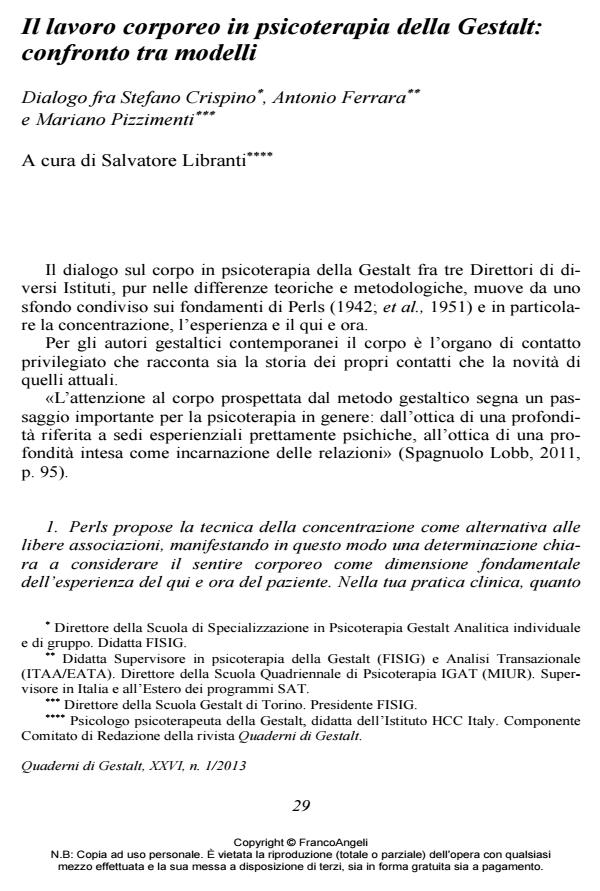Body work in Gestalt Therapy: comparison between models
Journal title QUADERNI DI GESTALT
Author/s Salvatore Libranti, Stefano Crispino, Antonio Ferrara, Mariano Pizzimenti
Publishing Year 2013 Issue 2013/1 Language Italian
Pages 11 P. 29-39 File size 490 KB
DOI 10.3280/GEST2013-001003
DOI is like a bar code for intellectual property: to have more infomation
click here
Below, you can see the article first page
If you want to buy this article in PDF format, you can do it, following the instructions to buy download credits

FrancoAngeli is member of Publishers International Linking Association, Inc (PILA), a not-for-profit association which run the CrossRef service enabling links to and from online scholarly content.
This is an interview to S. Crispino, A. Ferrara and M. Pizzimenti, founders of three Gestalt schools, highlighting the differences among them in the theory and methodology concerning body work in psychotherapy. Starting from the shared background of work on concentration and experience of here-and-now, the three leaders resort to relevant clinical examples for showing the thought, interventional methods and didactics they propose.
Keywords: Body in Gestalt psychotherapy, differences, shared background, concentration, experience, here-and-now
- Berne E. (1979). Ciao! … E Poi?. Milano: Bompiani.
- Ferrara A. (2009). Un esempio di Gestalt integrativa, e interviste: la pratica terapeutica come opportunità di lavoro su di sé. Un mini congresso sugli strumenti della psicoterapia. In: Naranjo C. Per una Gestalt viva. Roma: Astrolabio (ed. it. 2009).
- Ferrara A. (2011). Una Gestalt per i nostri tempi. In: Menditto M. (a cura di) Psicoterapia della Gestalt contemporanea. Milano: FrancoAngeli.
- Frank R. (2001). Il corpo consapevole. Un approccio somatico ed evolutivo alla psicoterapia. Milano: FrancoAngeli, 2005.
- Goulding M.M., Goulding R.L. (1983). Il cambiamento di vita con la terapia ridecisionale. Roma: Astrolabio.
- Kepner J. (1993). Body Process. Il lavoro con il corpo in psicoterapia. Milano: FrancoAngeli, 1997.
- Namkhai Norbu C. (1986). Dzog-chen. Lo stato di autoperfezione. Roma: Ubaldini Editore.
- Naranjo C. (1980). The Techniques of Gestalt Therapy. Highland, N.Y: The Gestalt Journal Press (trad. it.: Teoria e tecnica della Gestalt. Milano: Melusina, 1989).
- Perls F. (1942). Ego, Hunger and Aggression: a revision of Freud’s Theory and Method. London: G. Allen & Unwin, 1947; New York: Random Hause, 1969 (trad. it.: L’Io, la fame e l’aggressività. Milano: FrancoAngeli, 1995).
- Perls F., Hefferline R., Goodman P. (1951). Gestalt Therapy: Excitement and Growth in the Human Personality. New York: The Gestalt Journal Press (trad. it.: Terapia e pratica della terapia della Gestalt. Vitalità e accrescimento della personalità umana. Roma: Astrolabio, 1971; 1997).
- Reich W. (1994). Analisi del carattere. Milano: SugarCo.
- Spagnuolo Lobb M. (2005). Presentazione. In: Frank R. Il corpo consapevole. Un approccio somatico ed evolutivo alla psicoterapia. Milano: FrancoAngeli.
- Spagnuolo Lobb M. (2011). Il now-for-next in psicoterapia. La psicoterapia della Gestalt raccontata nella società post-moderna. Milano: FrancoAngeli.
- Stern D.N. (2004). The present moment in Psychotherapy and Everyday Life. New York: Norton (trad. it.: Il momento presente in psicoterapia e nella vita quotidiana. Milano: Raffaello Cortina, 2005).
Salvatore Libranti, Stefano Crispino, Antonio Ferrara, Mariano Pizzimenti, Il lavoro corporeo in psicoterapia della Gestalt: confronto tra modelli in "QUADERNI DI GESTALT" 1/2013, pp 29-39, DOI: 10.3280/GEST2013-001003